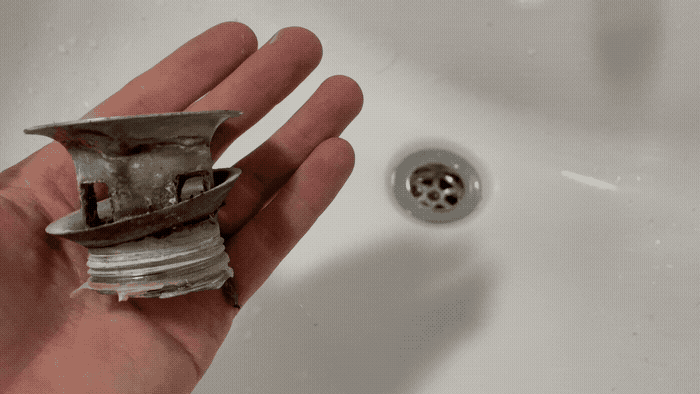Replace a sink waste
Americans call this a drain, but British people call it a waste. As I'm only about a week out from having to prove to the government that I've become adequately Anglicised to be allowed to stay here—I'm going to call it a waste. Anyway, it turns out that this is one of those jobs that you don't have to call a plumber to do for you.
Okay, cards on the table here: this is a guide for British sinks. I've just been on Lowes dot com and all the drains are weirdly long and a search for "bottle traps" just turns up a bunch of results for Bag-a-Bug Japanese beetle traps. It turns out that if you live in the United States you may need to call a plumber after all.
Wastes can be had for pretty cheap at e.g. Screwfix or Toolstation. Get a new bottle trap while you're at it—the anti-siphon ones are best and only cost an extra quid or two above the regular ones. Might be smart to get a bit of flexible piping as well, since bottle traps all seem to be about 3mm out of line with every other one.
The hardest part of the job will be getting the old waste out. If, like me, your wastes haven't been changed in fifteen years, they will be a repulsive, corroded catastrophe, adhered to the sink and to the sub-sink plumbing with a mess of grimy and expired silicone. If you're lucky, the black hex nut will be in place; if you're unlucky, there'll be some sort of chrome ring that will have fused itself galvanically to the waste, and the only solution will be your trusty hacksaw.
Once the waste is out, all that remains is assembly. A rubber gasket on the user-facing side of the sink sits under the waste flange itself.
Here is the most important step in the process: purchase a tub of Plumber's Mait and wrap a slug of the stuff around the threads of the waste before tightening down the hex nut. When you tighten the black hex nut down on the threads of the waste to seal it to the sink itself, the Plumber's Mait will squidge into all the nooks & crannies & out the sides and form a watertight seal. Silicone will not do the job: it's messy and thin, and besides not being watertight, it's very difficult to remove next time you need to replace the waste. Plumber's Mait is a fiver and is designed for this job specifically. You don't need to wait for it to dry; once you've tightened down the plastic hex nut (tight) and the Plumber's Mait has squeeged adequately, you can run water down the waste immediately (provided you have attached the trap, which is left as an exercise for the reader). Again: do not bother with silicone. If for whatever reason you do need a plumber to work on your sink, and they discover that you have used Plumber's Mait, they will shake your hand warmly and offer to buy you a pint. I am not kidding about this.
That is how you replace a sink waste:
- Remove the old waste, peeling off all the crummy old silicone left by the previous schmuck;
- Install the new waste, with the included rubber gasket between the waste flange and the sink tub;
- Apply Plumber's Mait to the threads under the sink;
- Tighten down the black hex nut slightly more than you feel comfortable with;
- Attach the (non-siphon) trap to the sink and the downpipe.
